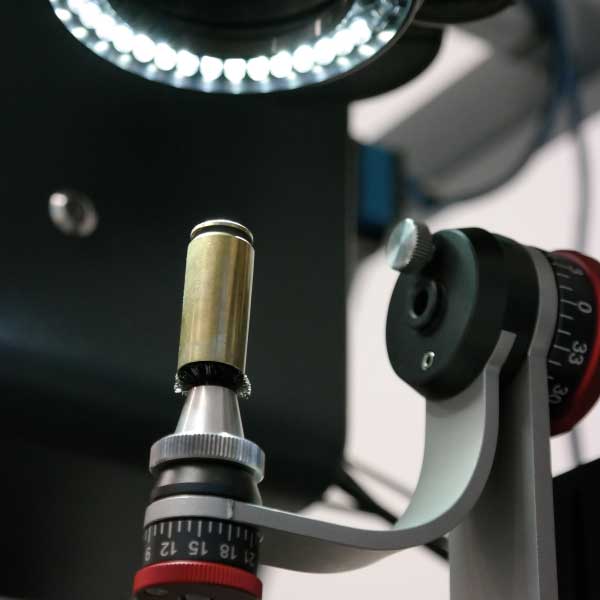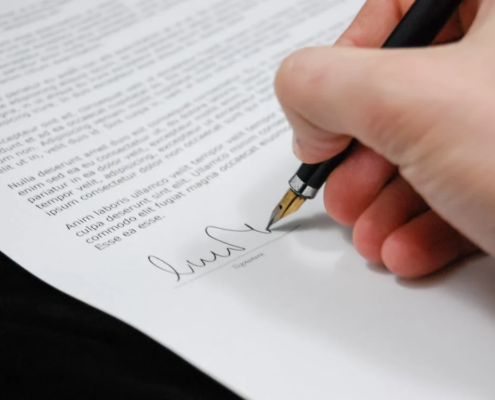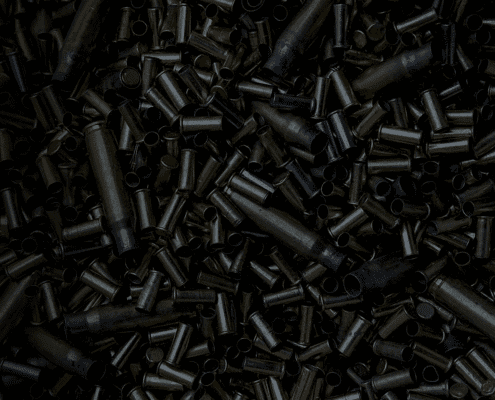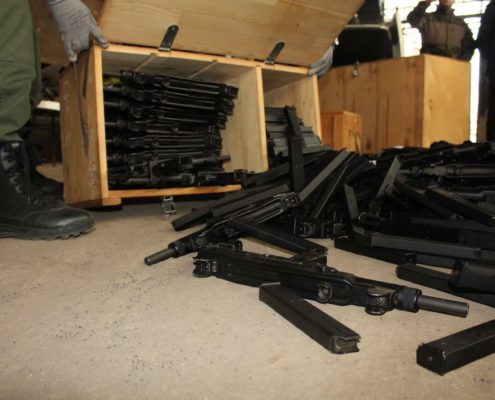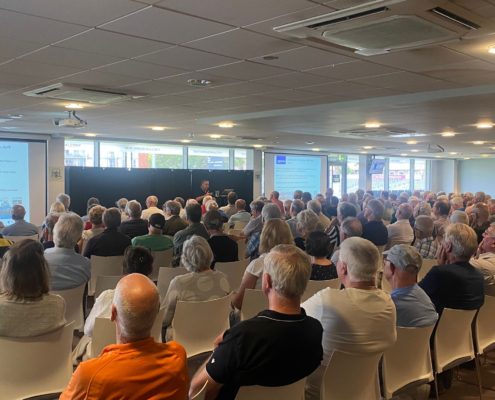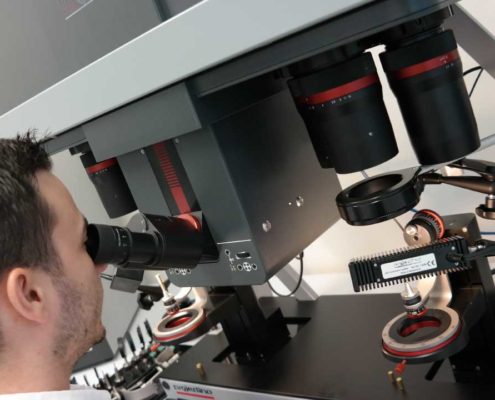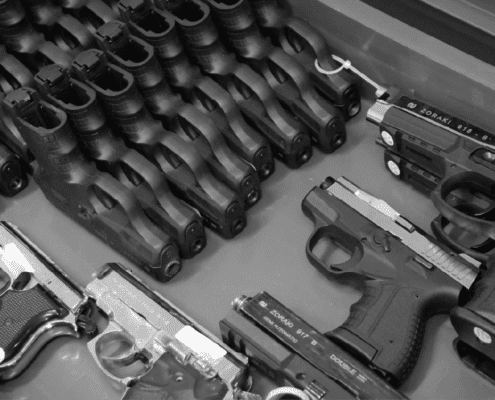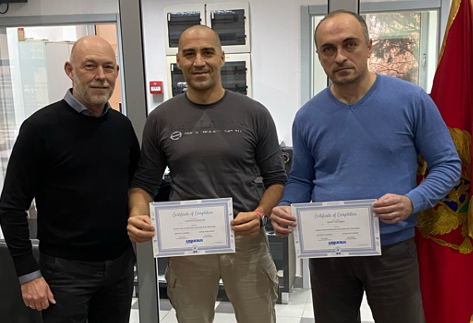 https://arquebus.uk/wp-content/uploads/2025/02/Picture-1-3.png
323
473
Rohan Harvey
https://arquebus.uk/wp-content/uploads/2022/02/Asset-1arquebus_logo.svg
Rohan Harvey2025-02-10 10:04:322025-02-10 15:23:07Arquebus Delivers Ballistic Examination Training in Montenegro
https://arquebus.uk/wp-content/uploads/2025/02/Picture-1-3.png
323
473
Rohan Harvey
https://arquebus.uk/wp-content/uploads/2022/02/Asset-1arquebus_logo.svg
Rohan Harvey2025-02-10 10:04:322025-02-10 15:23:07Arquebus Delivers Ballistic Examination Training in MontenegroUsing ballistics forensics, investigators can obtain a wealth of information on the criminal misuse of small arms, light weapons, and their ancillaries (SALW) from recovered weapons, tools, bullets, and cartridge cases. When this information is properly analysed and integrated with other relevant sources, it represents a powerful tool for law enforcement agencies combatting SALW-related criminality. Law enforcement can harness ballistics forensics to develop actionable tactical and strategic intelligence that can be used to investigate specific crimes, as well as understand broader trends in SALW misuse.
Arquebus is delighted to discuss the importance of ballistics forensics and the role it can play in a national SALW control strategy with our very own experts on ballistics, Glenn Lawrence and Dr Joanne Short.
§
Can you both introduce yourselves to our readers and explain your experience in ballistics forensics?
Jo: “Hi, I’m Joanne Short and I’ve had 23 years’ experience within forensics. I started way back in 2001 with the UK’s Forensic Science Service (FSS) where I trained to be a reporting officer. So, by the time I left the FSS 7 years later, I was attending crime scenes and fully reporting everything on the forensics side of things. I then spent 15 years as a Ballistics Expert with the National Ballistics Intelligence Service (NABIS), where my examinations centred around firearms intelligence. In 2023, I joined the team at Arquebus, where I now specialise in working with IBIS as a ballistics technician.”
Glenn: “Hi, I’m Glenn Lawrence. I have a background in technology businesses and forensic fingerprint and footwear analysis at the UK Home Office Scientific Development Branch. I’ve worked in over 30 different firearms laboratories across the world, providing training, process development and casework support. I’ve been with Arquebus for just over 10 years now, primarily supporting them with casework, using IBIS, developing processes, training, developing test-fire programs and other technical projects.”
To begin with, what is ballistics forensics, and what can forensic analysis tell us about the misuse of firearms?
Jo: “From my experience, forensics is all directed around helping an investigation at the point where there is an incident – the police know nothing other than a firearm has been discharged, with bullets and cartridge cases potentially being left at the crime scene, or a subsequent weapon recovery. Ballistics forensics is about examining these items and trying to give investigators as much information as you can about the weapon type as well as identifying associations you might find between that incident and perhaps an incident from last week, last month, or even five years ago. It’s nice to be able to turn around and say ‘yeah, it’s this type of weapon and it’s been used here before’ – it’s really helpful to the police so they know what firearm they are looking for.”
Glenn: “Firearms are essentially a tool, leaving behind ballistic material which bears tool marks on the surfaces that are in contact with the firearm. As Jo said, what we’re really interested in from an internal ballistics perspective is the comparison of those tool marks so we can link them to other incidents, or to recovered weapons. But aside from that, you have other forms of Ballistics forensics. External ballistics looks at the behaviour of projectiles whilst in flight, which deals with things like trajectory and can help investigators reconstruct a crime scene. Then there’s terminal ballistics, which can provide information about the projectile by looking at wounds or surface damage to the inside of properties. All this gives you intelligence about the weapon that might have been fired, especially when you’re considering whether a weapon has potentially been converted, modified or reactivated.”
How can varying forensic disciplines be integrated to develop ‘inside and outside the gun’ intelligence?
Jo: “It’s important that all forensic avenues are explored in a firearms investigation. Obviously, you’ve got things like DNA and fingerprints, but there’s also trace evidence on lots of weapons that I’ve come across in my time. Things like paint chips, fibres and glass fragments can all be good sources of intelligence. When DNA or fingerprints are found inside the weapon, especially where it’s been modified, converted or privately manufactured, it can help investigators identify the individual making the alterations or the workshop in which they’re operating. You can bring together all these forensic disciplines to provide investigators with as much information as possible about an incident, but also use them to find out the origins of a weapon, its manufacturer or even its supply route.”
Glenn: “I’d also add that its sometimes necessary to consider what people mean by inside and outside the gun intelligence – it’s a somewhat confusing analogy. Things like DNA and fingerprints are typically considered outside of the gun information, but sometimes you are looking inside the gun for those things, especially when investigating converted weapons. It’s also worth noting that ‘outside the gun’ doesn’t just refer to forensic data but includes supporting or additional information related to the crime, the firearm or the suspect. Things like the perpetrator’s criminal history, the legal status of the firearm, or the serial number of a firearm all come under this category as well.”
Following on from the previous question, what is ‘match analysis’?
Jo: “It’s essentially comparing two ballistic specimens and looking for areas of potential agreement and disagreement. When I used to work in a laboratory, we’d take two cartridge cases or two bullets and you put them side-by-side on a comparison microscope, which is where you have two separate stages set up and you’re able to bring the images alongside each other and make comparisons between the two. We do the same now with IBIS, apart from we’re using digital images instead of having the physical items. You’re trying to find certain marks left on the projectiles which are in agreement with each other and indicate shared weapon characteristics. These can be divided into class, sub-class and unique agreements; a class agreement suggests the projectiles were discharged from the same type of weapon or perhaps the same manufacturer, whereas a sub-class agreement suggests the weapons shared the same manufacturing process or were made in the same batch. Unique characteristics are specific to a single gun – literally small imperfections that can be caused from things like wear and tear.”
Glenn: “As Jo said, it’s about finding likeness, or ‘sufficient agreement’ between two samples, as the AFTE Theory of Identification puts it. This means that the samples are more likely to be a match than they are to be a non-match. We’re looking at things like the firing pin impression or the breach face characteristics from where the primer is pushed back into the breach of the firearm on the headstamp of a cartridge, or the ejector mechanism leaving a mark. From a bullet perspective or projectile perspective, it’s the striations marks. Those unique imperfections and irregularities are the ones that can allow you to determine if two samples are a match.”
What products and outputs are typically developed by forensic laboratories, and how does this aid investigators? How should forensics laboratories prioritise evidential and intelligence workflows?
Jo: “When I worked at the FSS, prosecutors were provided with evidential products and investigators with intelligence products. Evidential workflows are about gathering forensic information about an incident for the police and prosecutors, so they can hold somebody accountable, charge them for a firearms-related offence and bring them before a court. This process can be slow because you’ve got to be thorough and consider things like the legal classification of the firearm, supply routes and link them all to the suspect – this can take time. The intelligence side can help to lead you towards a suspect and a gun before you can even think about arresting somebody. This should happen as quickly as possible so you can direct an investigation at the early stages after a gun’s been discharged – this should be the priority of forensic laboratories.”
Glenn: “Yes, the intelligence workflow is all about providing the relevant forensic information on a firearm-related incident to the police in fast time. This is to capitalise on the so-called ‘golden hours’ of an investigation – the idea that early action can result in securing significant intelligence that would otherwise be lost. For example, I know the forensic laboratories at NABIS try to get ballistics comparison done within 24 to 48 hours of an firearms incident, so that the police can potentially link it to other crimes. In the UK, we’ve probably got the prioritisation of intelligence versus evidential workflows about right now, though historically we didn’t, and many other countries certainly struggle to find that balance.”
Touching on that point, based on your experience, what are the common issues you’d identify as limiting forensic laboratories’ effectiveness?
Glenn: “Well that balance between intelligence and evidence is quite difficult to find in places where the prosecutors may own the evidence. They will often direct specific forensic analysis to be done on the recovered material that they think will help their case, not particularly knowing what is needed because they are not a specialist. For example, you may find a cartridge case from a crime scene that clearly shows it was a modified blank cartridge with a projectile. Therefore, you know you’ve probably got a converted weapon on your hands and that maybe there’s other evidential processes or even intelligence-based processes that need to be pursued. I’ve seen many countries recover firearms that are converted firearms and just label them as legitimate firearms, because the experts at the recovery of the crime scene either don’t know what they’re dealing with or are being directed by the prosecutor, and then take it down an incorrect workflow – It is quite far and removed from the intelligence based approach.”
Jo: “I agree, getting that balance is important and it’s very hard if there are these other structures in the way that prevent them from operating in a fast-time intelligence work mode. I’d also say that a significant limitation can be the unwillingness of police forces to share forensic information with one another. To really be effective at looking at gun crime in a country, you must have a real national picture – that’s unfortunately what’s missing most of the time. This is further complicated when a case has cross-border connections. Sometimes authorities need forcing round a table to discuss best process and to ensure that ballistic forensic intelligence is shared, and the investigation can run its course.”
In your experience, what emerging threats are there regarding illicit circulation firearms, particularly in a European context? Why are they particularly concerning?
Jo: “From a forensics angle, 3D-printed guns and ‘ghost guns’ have to be up there, as they represent a real threat in terms of traceability. There also seems to be a move towards fully automatic pistols, which is a real issue. It used to be assault rifles,; big guns that you could see, and you could potentially monitor the movement of a bit more readily than you can with small handguns that are more discreet and readily concealable.”
Glenn: “Yes, I fully agree with those. I guess we can both look at this from the perspective of trends in firearm types, but also identify where problems are going to come from in terms of supply. Using Ukraine as a reference point, we probably expect that, although it’s absorbing the majority of firearms in the region at the moment, there will come a point when stability is reached that some of those weapons will unfortunately end up being involved in crime. There is a considerable risk of repeating the situation we had after the conflict in the Western Balkans, which left a large number of unregistered firearms in circulation and has been one of the main sources for firearms smuggled into Western Europe over the last few decades.”
Turning to legal circulation firearms, to what extent can ballistics forensics play a preventative role in a national SALW control strategy?
Glenn: “I think ballistics forensics is important for two major components of a SALW control strategy. Firstly, by virtue of what the science is about, it takes illicit SALW off the streets and helps convict the criminals who misuse them. It enhances national security by enabling police to determine that a certain firearm was used in a crime, recover it from a particular person, and potentially link it to another incident – this ultimately prevents the criminal misuse of SALW. Secondly, I think ballistic test-fire programmes can be hugely important for detecting instances where state and civilian SALW are being diverted into illicit use. These programmes take the ballistic signature of legally held firearms and hold them in systems like IBIS, so that they are flagged when we conduct a match analysis on material left at a crime scene. Although this dimension doesn’t particularly help if the main issue is privately made or trafficked SALW.”
Jo: “I completely agree with Glenn. Ballistic test-fire programmes could be a real help in places like the UK where some guns recovered have been stolen from legal owners. To make a broader point though, forensic laboratories need to be supported with investment as part of a SALW control strategy. To properly harness ballistics forensics, for both the intelligence and evidential purposes, they need to be given the right technologies and the personnel need sufficient training to underpin these strategies – ballistics examination cannot be learnt overnight. I also think ballistic forensics is only one part of a SALW control strategy. There needs to be efforts to curb firearms activity in general via effective legislation because the criminal fraternity are very creative and will exploit legal loopholes at every opportunity.”
§
In summary, this Q&A has explored the ways in which ballistics forensics can contribute to a successful national SALW control strategy through helping law enforcement to investigate SALW-related criminality, remove SALW from circulation and better understand the nature of SALW misuse in their respective jurisdiction.
Going forward, next month’s blog post will consider the importance of national firearm focal points in developing and enhancing information, intelligence and forensic data to effectively combat the criminal misuse of SALW.
